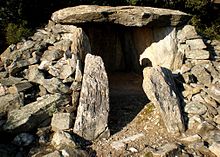Minervois (landscape)
The Minervois ( Occitan Menerbés ) is a cultural and wine landscape in the south of France ( Languedoc ), which is named after the place Minerve .
location
The Minervois comprises parts of the Aude and Hérault departments and is bounded in the north by the southwestern foothills of the Massif Central ( Montagne Noire and Causses ). In the south the river Aude and the Canal du Midi form the border; further south are the Corbières (mountainous country) , a mountainous area with many gorges. In the east the Minervois opens to the coastal plains of the Mediterranean and in the west to the area around Carcassonne .
economy
Viticulture and trade
Viticulture has been practiced in the Minervois region since ancient times and Gallo-Roman times.
Due to its location on the only east-west connection in the south of France, one would expect that trade or supplying the merchants passing through would have played a greater role, but there is no larger city, i. H. no economic or cultural center in the Minervois.
tourism
Places like Rieux-Minervois and Caunes-Minervois were on a branch route of the medieval pilgrimage route to Santiago de Compostela ( Via Tolosana ).
The autumn grape harvest has always drawn people from other regions of France to the Minervois. Tourism has played an important role in the economic life of the villages and towns of the Minervois since the 1970s and 1980s. Holiday houses ( gîtes ) as well as small guest houses and hotels can be found everywhere without the landscape having been sprawled or the lives of the residents having changed to a great extent, because it is mainly French who spend their holidays here.
Cities and villages
The largest town in the Minervois is Rieux-Minervois with around 2000 inhabitants, followed by Caunes-Minervois and Olonzac with around 1500 inhabitants each. Most towns have a population of around 250 to 500.
history
The area was already settled in prehistoric times, as indicated by the many dolmens or passage graves ( allées couvertes ) from the time of the megalithic cultures . Small finds from Roman and Gallo-Roman times were also made.
In the Middle Ages, most places were fortified by city walls, because experience shows that there were attacks from time to time. But only once in its history, namely during the Albigensian Wars , did the Minervois play an important historical role. Minerve was one of the last places of retreat for the Cathars until the siege and dramatic conquest of the city in the summer of 1210 by the troops of Simon de Montfort . In Caunes, Pierre Isarn, one of the last Albigensian bishops, was burned at the stake in 1226 .
While the Hundred Years War (1337-1453) between the English and the French - apart from the surprise campaign of the 'Black Prince' ( Edward of Woodstock ) to Narbonne (1355), in which Pépieux was pillaged - more played out in southwest France, the time brought the Huguenot Wars (1562–1598) Riot and destruction in the landscape of the Minervois.
From the time of the French Revolution , as in other rural regions of France, there is hardly any news from the Minervois; nothing is known of mutual denunciations or of executions on the guillotine .
Attractions

In spite of the lack of a significant historical role and cultural center, the Minervois is rich in places of interest:
Dolmen
- Dolmen Lo Morrel dos Fados near Pépieux
- Dolmen at Villeneuve-Minervois
- Passage grave near Laure-Minervois
Romanesque

- Notre-Dame de l'Assomption church in Rieux-Minervois
- Abbey Church of St-Pierre et St-Paul de Caunes-Minervois
- Church of St-Germain at Cesseras
- Chapel of St-Étienne-de-Tersan near Azille
- Church of St Martin in Beaufort (Hérault)
Gothic
- Church of St-Étienne in Pépieux
- Church of St-Jean-Baptiste in Laure-Minervois
- Church of St-Geniès in Cesseras
places
- Minerve , one of the ' most beautiful villages in France '
- Azillanet , a small wine town

